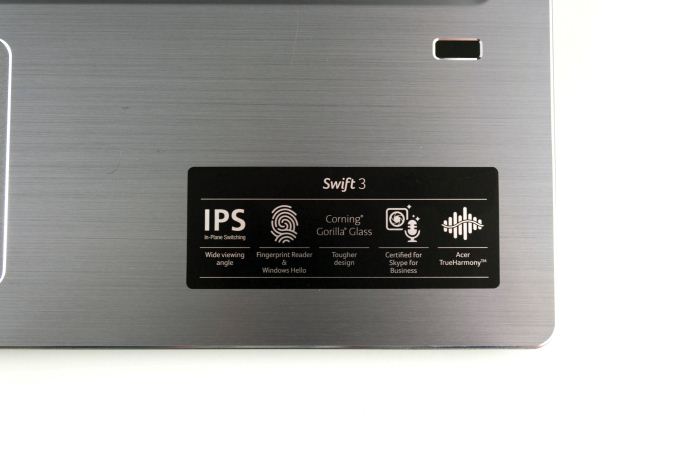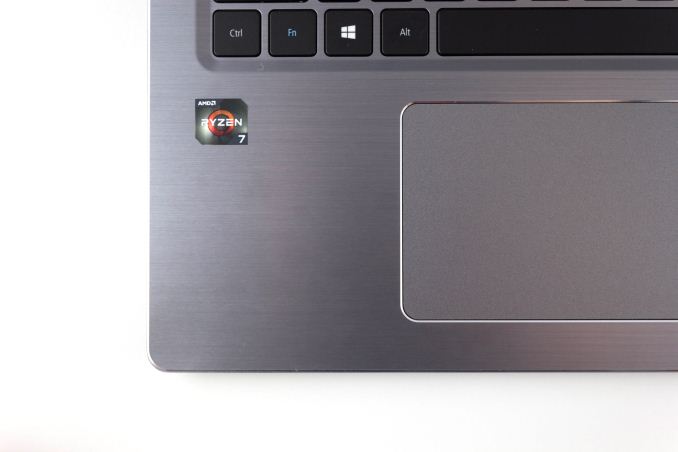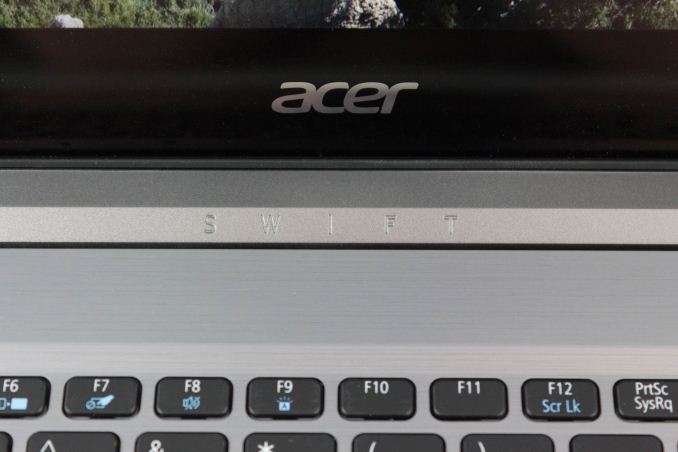The Acer Swift 3 SF315-41 Review: Ryzen Meets Laptop
by Brett Howse on May 3, 2018 8:00 AM EST- Posted in
- Laptops
- Acer
- AMD
- Ryzen
- Ryzen Mobile
- Raven Ridge
Final Words
This review is really looking at two things. First, the Acer Swift 3, and second, the AMD Raven Ridge platform based on Ryzen mobile. Let’s start with the laptop.
Acer’s Swift lineup features models from the Swift 1 at the value end, to the Swift 7 at the top end. So, the Swift 3 is closer to the value end than Acer’s flagship models. But that’s somewhat deceptive because Acer’s Swift 3 is a nicely built device, with a great aluminum exterior, an IPS display, SSD storage, and even a fingerprint reader alongside the excellent trackpad.
It’s not all sunshine and roses for the Swift 3 though. The keyboard is not only cramped with the number pad squeezed in on the right, but the keys themselves are also very poor, with a slippery texture that makes it very easy to miss the key you’re looking for. It does feature backlighting, but the backlighting turns off quickly, and using the trackpad doesn’t light up the keys like it does on most laptops.
The small battery also cuts into the maximum life when not plugged in, and that’s purely a cost decision because there’s plenty of room inside a notebook this big for more battery. Plus, the high baseline power draw pulls down the battery life as well. Compared to a couple of years ago, the battery life is still quite good, but it’s definitely not all day by any means.
The display has great grayscale and white levels, but doesn’t even come close to covering the entire sRGB spectrum, which is something that most laptops do now. At 1920x1080, it does offer enough resolution at least, and of course it’s IPS which is a requirement at this point.
AMD’s Raven Ridge platform has done very well though. The CPU performance is much stronger than the outgoing Carrizo notebook platform, although it’s not quite up to the latest Kaby Lake in terms of absolute performance. But the addition of a real GPU onto the SoC is a welcome change, and allows actual 3D gaming even on a 15-Watt processor. The performance of the Vega GPU is so much better than the Intel integrated solution that really adds a lot of capability.
The combination of AMD’s Ryzen mobile, along with a good design, and excellent specifications for the price, really do make the Acer Swift 3 an appealing proposition. We’ve never tested a laptop at this price point with a 512 GB SSD before, and the 8 GB of DDR4 is very welcome as well at this price. If you can get over the poor quality keyboard, there’s a lot of laptop for the dollar here, and the ability to actually run real games is a welcome change.













78 Comments
View All Comments
jaydee - Thursday, May 3, 2018 - link
Looking forward to Ryzen hitting the business line notebooks (Elitebook/Latitudes). Lot of employees at my company are still being given the woeful Elitebook 745 G3 (Carrizo) as of today, as band new laptops for a 4 year cycle...Jimster480 - Monday, May 28, 2018 - link
They did, and the offerings are atrocious and insanely overpriced.Valantar - Thursday, May 3, 2018 - link
This is very promising in terms of performance, even if AMD still needs to convince OEMs to build more premium SKUs with Ryzen mobile. Also, that base platform power draw needs fixing, for sure. Wonder how much of that is RAM, but I suppose that would be pretty much impossible to measure.Related to that: why doesn't RAM have some sort of turbo/power saving implementation like CPUs? Given that this likely runs dual channel 1.2V DDR4 at ~2400MT/s, couldn't the base power draw benefit massively from downclocking the RAM to, say, 1600MT/s at idle and simultaneously lowering voltage? I get that this isn't part of the DDR4 spec, and that the ICs and DIMMs as such aren't tested or certified for lower voltages and speeds, but the lack of dynamism in RAM is starting to feel old. The same goes for high-speed desktop RAM, really - why run 3600MT/s RAM idling at the desktop? It can't possibly be /that/ hard to implement a two-state (e.g. "low power" and "normal") dynamic system that's directly tied to other system loads (not just CPU, but GPU, RAM, network and disk activity too). Tuning the boost/de-clock triggers and control algorithms would likely require a bit of work, but is this really that hard to do?
I suppose this could trip up a few applications that are highly reliant on timely RAM access, but those can't be very common in normal consumer usage - and I don't envision this catching on in datcenters and the like. Might that be why we still haven't seen something like this, as businesses and server OEMs don't care?
DanNeely - Thursday, May 3, 2018 - link
If idle link throttling of DDR ever happens, I'd expect it to happen first on mobile, and then work its way up though LPDDR, to regular DDR specs. OTOH GDDR has been able to do this for a while, so it's definitely doable without seriously impacting peak performance. GPUs are power pigs, and lower idle power has been a major improvement over the last decade; but it's a segment not willing to sacrifice performance at the top to get it.You're probably right about it never making it to the data center. I've read that a number of the major cloud platforms have disabled CPU clock throttling and run at full speed 24/7 regardless of the actual load because serving responses at low speed and/or boosting back up from idle to full speed have measurable impacts on latency and the major web companies care about every millisecond there.
neblogai - Friday, May 4, 2018 - link
Gaming benchmarks show mobile Raven Ridge processors doing exactly that: RAM clock changes in the game, 933-1066-1200. You can see such behaviour in TechEpiphany's videos on youtube. However- because this is not something seen before- these readings are semi-discarded. In would be great if someone tested it properly, or asked AMD if this is how it really works, and is not an error by monitoring software.HStewart - Thursday, May 3, 2018 - link
I think for comparison, it would have been nice to test the Intel version of same model - I found it interesting that 2700 version was more expensive than the Intel with MX150. Also the Intel model was less weight which tells me Intel components are more compact. The 2700 model had more ssd but that should not be that way.Cooe - Thursday, May 3, 2018 - link
It's because of the doubled SSD size that the 2700 model is more expensive obviously.Jimster480 - Monday, May 28, 2018 - link
Its not that because the AMD machines are relegated to cheap SATA bottom of the barrel drives and ultra cheap screens. The price is just Intel making sure that nobody is going to make a competitive notebook.This laptop doesn't even land in "mainstream" it lands in "ultra budget with such a big price nobody will buy it". The screen, SSD, battery, wifi, chassis, keyboard are all unacceptable for this price range and Acer knows it aswell. But the check they receive from intel outweighs the obvious lack of sales they will have for this model.
Stuka87 - Thursday, May 3, 2018 - link
I would be surprised if you could tell the weight difference between the two. Its 4 ounces. And the Intel is cheaper because its SSD is half the size.Krysto - Thursday, May 3, 2018 - link
Still only 8GB of RAM?! Come on.